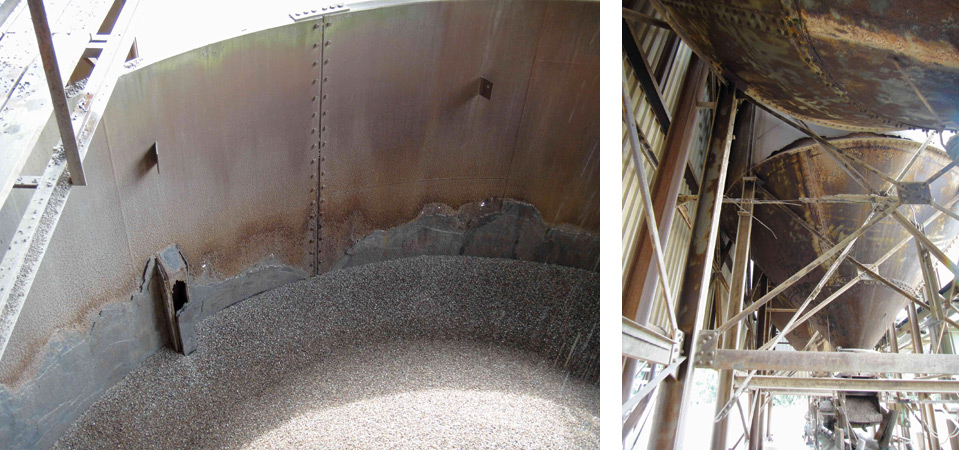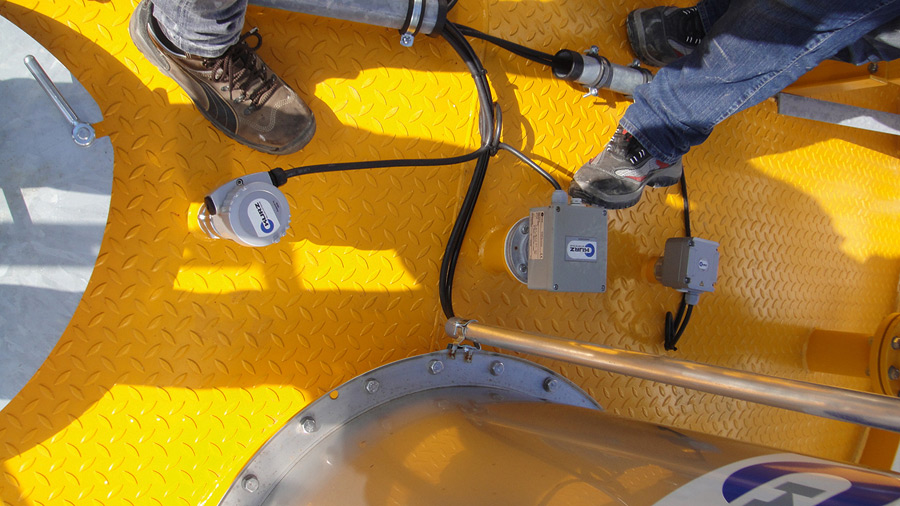Silos within the meaning of the German Statutory Accident Insurance (DGUV) Regulation 113-004 “Containers, silos and confined spaces” are
- containers and confined spaces;
- areas surrounded on all sides or predominantly by solid walls;
- areas with poor ventilation;
- areas in which special hazards that significantly exceed the hazard potential normally present in workplaces exist or may arise because of the confined space of the area or because of the substances, preparations, contaminants or equipment that are present or stored there.
Hazards
In the course of their use, silos (Figure 1) and their discharge devices wear out at different rates depending on the abrasive, i. e. grinding/frictional, properties of the stored material. This can affect the impermeability of the silo walls as well as the stability of the silo structure.
The stability is also impacted by weathering influences such as wind, snow or standing moisture. External influences such as the application of the supports, the creation of negative pressure inside the containers when the material is removed or of positive pressure during filling can also lead to instability of the silo.
Further hazards can result from the functional efficiency of the auxiliary units required for operation of the silo. Overfill prevention devices, level indicators, explosion protection flaps, venting devices or filter elements are especially common units of this type. Alarmingly, there are also in actual practice examples of the impairment of the stability of silo installations when load-bearing parts of the structure have been removed and have not been reinstalled owing to lack of space or other reasons.
Regular inspection
Ensuring the safe operation of the silo requires regular maintenance of the entire structure and auxiliary units in accordance with regulations. Construction law defines stationary silo installations as structures with permanent contact to the ground, i.e. buildings. Structural facilities must be maintained in such a way that public safety and order, in particular the safety of life, health and the natural living conditions, are not endangered. Owners or the parties with authorised control of the property have always been held accountable for proper maintenance, i. e. servicing, inspection and, as necessary, repair as well as for the traffic safety of the building.
Regular inspections ensure that the load-bearing structure remains stable throughout the entire service life of the silo system and that the necessity of upgrading measures required to ensure the load-bearing capacity is recognised in good time. A possible gradated procedure for the verification of stability consists of the following:
- inspection by the owners or parties with authorised control of the property;
- visual inspection by a qualified person; and
- comprehensive inspection by a specially qualified person.
The walk-through inspection includes examination of the structure for obvious damage. Obvious damage to load-bearing components such as columns, walls and roof and ceiling girders and trusses encompasses mainly deformations, tilting, cracks, moisture penetration, efflorescence and corrosion (Figures 2, 3).
In addition to inspecting the condition of the load-bearing structure, it is advisable to check whether there are any other factors that may negatively impact stability such as moisture penetration from the exterior, damaged drainage systems or adverse climatic conditions inside the building.
It is recommended that the functional efficiency of the silo system’s auxiliary units such as full indicators, pressure switches, pinch valves, exhaust air filters and overpressure and vacuum safety devices be checked (Figure 4) at the same time during these inspections.
As a rule, the walk-through inspection serves as an interim check between inspections by qualified persons. If damage is found, the owner/party with authorised control of the property is advised to consult a qualified or specially qualified person insofar as the former is not himself a qualified person.
Qualified persons include, e. g., civil engineers and architects who can prove that they have been involved in the issue of stability certificates, in technical construction management and in comparable activities for a minimum of five years and that they have been involved in the issue of stability certificates for at least three of those years. They should be able to document their experience with comparable structures.
Specially qualified persons are primarily civil engineers who can prove that they have been involved in the issue of stability certificates, in technical construction management and in comparable activities for a minimum of ten years and that they have been involved in the issue of stability certificates for at least five of those years and in technical construction management for at least one year.
Visual inspections by a qualified person may – insofar as justifiable – be conducted without the use of aids in the form of an intensive, extended walk-through inspection by, e. g., a construction technician/civil engineer. If damage that might impair stability is found, it is advisable, if there is any uncertainty, to consult a specially qualified person.
During the comprehensive inspection, all relevant structural parts, including those that are difficult to access, are as a rule inspected at close proximity for damage by a specially qualified person (Figure 5). Random material examinations may also be necessary. The inspection may also be limited to random checks, especially if the specially qualified person is already familiar with the supporting structure.
Further details on the conduct of the inspection can be found inter alia in the “Guidelines for the Inspection of the Stability of Structural Facilities by the Owner/Party with Authorised Control of the Property” issued by the Building Ministers Conference for Urban Development, Construction and Housing (ARGEBAU) as last revised in September 2006. VDI Regulation 6200 “Stability of Structures – Regular Inspection” provides useful information for determination of inspection intervals. Experts base their recommendations for inspections as shown in Table 1 for the sizes of facilities commonly found in the building materials industry on these regulations.

Table 1. Recommended inspections for the sizes of facilities commonly found in the building materials industry.



